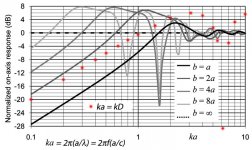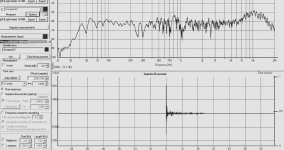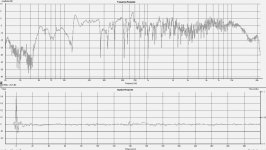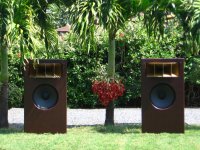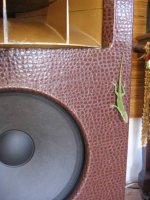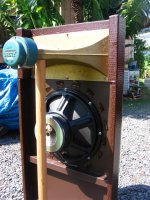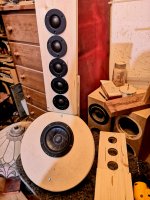In my book:
1. best of both world solution = felt baffle (for mid)
2. choose your evil solution = large baffle with asymmetrical driver placement OR no-baffle
3. pointless non-solution = minimalist baffle with silly shape
zmyrna,
I've spent considerable time reading SL's website, built two of his designs (Orion 3.3 and LXmini) and am very satisfied with the results. Where can I read this book of yours that supports your three assertions?🙄
Thank you. So, why doesn't he use normally sized baffles?
I am trying to understand. What does the (unequalised) axial response look like with a LX521 baffle? Does it not have a series of nulls?
Well, he would consider his baffle design sizes "normal." I'm not sure what "normal" for somebody else is. Somewhere between no baffle and mounting centered in a 4'x 8' sheet of plywood??
The un-equalized response of the LX521 system is shown on the Linkwitz Lab website somewhere.....but I can't seem to find it right now. 🙂 I will post again when I find it.
Dave.
Kevin, that is a very very poor argument...
FYI I do not believe in Jesus or the Bible either!
You seem to have invested in two Linkwitz builts and not able to handle any theoretical criticism re his designs. Relax; I am sure those speakers sound really good.
LXmini is a no-baffle design BTW
Read here (scroll down to A3):
Electro-acoustic models
Linkwitz wrote "Above the dipole peak the ripple is minimal for the unbaffled piston. This was also confirmed in the development of the LX521 midrange baffle shape."
FYI I do not believe in Jesus or the Bible either!
You seem to have invested in two Linkwitz builts and not able to handle any theoretical criticism re his designs. Relax; I am sure those speakers sound really good.
LXmini is a no-baffle design BTW
Read here (scroll down to A3):
Electro-acoustic models
Linkwitz wrote "Above the dipole peak the ripple is minimal for the unbaffled piston. This was also confirmed in the development of the LX521 midrange baffle shape."
Attachments
Last edited:
Baffle dimensions are critical element of dipole designs. Shortest distance from driver center to edge of baffle determines range of dipole radiation and diffraction ripples above dipole null.
Dipolplus - Alles über offene Schallwände (in German but you will get the idea!)
A nice simulator Home of the Edge
Dipolplus - Alles über offene Schallwände (in German but you will get the idea!)
A nice simulator Home of the Edge
Kevin, that is a very very poor argument...
FYI I do not believe in Jesus or the Bible either!
You seem to have invested in two Linkwitz builts and not able to handle any theoretical criticism re his designs. Relax; I am sure those speakers sound really good.
LXmini is a no-baffle design BTW
Read here (scroll down to A3):
Electro-acoustic models
Linkwitz wrote "Above the dipole peak the ripple is minimal for the unbaffled piston. This was also confirmed in the development of the LX521 midrange baffle shape."
zmyrna,
Wow...I simply asked you to provide support for your three assertions. Methinks it is you who need to relax. Oh and I believe religion is off topic here....
Shortest distance from driver center to edge of baffle determines range of dipole radiation and diffraction ripples above dipole null.
I will show you the response of my open baffle 95db sensitive powered with 15 watts of S.e.t. amplification.
The woofers are installed off-center in 4x7 feet plywood and cornered in the room, they create almost open baffle bass.
2 meter on axis (some floor bouncing below 1khz)
I will show you the response of my open baffle 95db sensitive powered with 15 watts of S.e.t. amplification.
The woofers are installed off-center in 4x7 feet plywood and cornered in the room, they create almost open baffle bass.
2 meter on axis (some floor bouncing below 1khz)
Attachments
Hey Dave. My first "successful" OB build was horn and woofer about 10 years ago. It was simple, an Altec 811 horn up top and a Selenium 15" woofer below. That woofer isn't made any more, but it was a 0.7 Qts driver and just right for OB. The learning curve on the crossover was very steep, but I finally got it and started to understand OB crossovers.I've been playing around with horns and have been thinking about using OB for bass and my horns for mid.....
I called them the "Lounge Lizards". I'll dig up some photos and you'll see why.
They were really quite good, with a big open sound, natural tonality and great dynamics. Apparently many of my neighbors liked them, too, as they frequently complimented my music. 😀
Here are some photos of my horn on open baffle Lounge Lizards. As you can see, very simple - and were very enjoyable speakers. It does not take complication to get great results.
Attachments
LOL, thanks Dave. 
If I were to do it again, I'd put some nice gold grill cloth in front of the woofer (to match the horns) and use black or brown double knit around the back to hide everything. My wife loved the speakers and helped build them, but always complained about being able to "see the parts and wire and stuff". WAF does matter.

If I were to do it again, I'd put some nice gold grill cloth in front of the woofer (to match the horns) and use black or brown double knit around the back to hide everything. My wife loved the speakers and helped build them, but always complained about being able to "see the parts and wire and stuff". WAF does matter.
Thanks Pano for the update 🙂 ! (good for Iggy & The Stooges listenings)
If money, swap the lizard with Galuchat (for richer sound)
If money, swap the lizard with Galuchat (for richer sound)
Last edited:
A semi open baffle experiment underway.
I like my 12 inch full rangers in open baffles, and yet wound up augmenting them with horns.
After a bit of thought, I'm trying some design goals which will have the upper midrange and treble be produced with identical drivers for greater coherence than a conventional tweeter and mid-woofer duo. Whatever dispersion comes with a regular single dome tweeter. And due to the configuration, narrower than usual vertical dispersion to limit ceiling and floor reflections, while keeping centre fill with wide lateral dispersion.
The woofer is angled 45°, to limit front wall reflections at the listening position, and also limit and remaining audible cone breakup.
The MMTMM crossover frequency amongst themselves are based on quarterwave frequencies matching their centre to centre spacing, except for the mid tweeters to tweeter spacing, which would be a mere 1.35" centre to centre at the manufacture's recommended crossover point. Edge to edge, this is a 2.875" centre to centre spacing, still far less than a typical woofer tweeter spacing combo, so it'll do for an experiment. Before someone posts that they know a term called comb filtering, I am interested in hearing their solution using these same drivers.
The midrange tweeters will be crossed as low as 1200 hertz, since I think they're at minimum 6db more efficient than the woofer, and probably more from a proximity boost from each other, as well as the load being shared by four drivers for each channel. Tests will be cautiously done with familiar music playing, using an active 4th order crossover between the mid tweeters and woofer.
There will be no measurements, since I'm building these to listen to, and don't care if a graph would look like other speakers designed by a computer.
I like my 12 inch full rangers in open baffles, and yet wound up augmenting them with horns.
After a bit of thought, I'm trying some design goals which will have the upper midrange and treble be produced with identical drivers for greater coherence than a conventional tweeter and mid-woofer duo. Whatever dispersion comes with a regular single dome tweeter. And due to the configuration, narrower than usual vertical dispersion to limit ceiling and floor reflections, while keeping centre fill with wide lateral dispersion.
The woofer is angled 45°, to limit front wall reflections at the listening position, and also limit and remaining audible cone breakup.
The MMTMM crossover frequency amongst themselves are based on quarterwave frequencies matching their centre to centre spacing, except for the mid tweeters to tweeter spacing, which would be a mere 1.35" centre to centre at the manufacture's recommended crossover point. Edge to edge, this is a 2.875" centre to centre spacing, still far less than a typical woofer tweeter spacing combo, so it'll do for an experiment. Before someone posts that they know a term called comb filtering, I am interested in hearing their solution using these same drivers.
The midrange tweeters will be crossed as low as 1200 hertz, since I think they're at minimum 6db more efficient than the woofer, and probably more from a proximity boost from each other, as well as the load being shared by four drivers for each channel. Tests will be cautiously done with familiar music playing, using an active 4th order crossover between the mid tweeters and woofer.
There will be no measurements, since I'm building these to listen to, and don't care if a graph would look like other speakers designed by a computer.
Attachments
Hello,
I have a question !
On this page
http://www.troelsgravesen.dk/OBL-15.htm
Troel explains that to go from the Ciare (388 mm) to the Faital (393 mm), I therefore had to " route the black part of the front panels"
I do not understand this sentence he widened the front of the cabinet where he directly touched the woofer
How to widen the front face by 3 mm? Because my front face is 388 mm
what tool to use to simply cut 3 mm
I have a question !
On this page
http://www.troelsgravesen.dk/OBL-15.htm
Troel explains that to go from the Ciare (388 mm) to the Faital (393 mm), I therefore had to " route the black part of the front panels"
I do not understand this sentence he widened the front of the cabinet where he directly touched the woofer
How to widen the front face by 3 mm? Because my front face is 388 mm
what tool to use to simply cut 3 mm
Troels is referring to the opening into which the bass speaker mounts. With the Ciare he routed fro 388mm diameter while for the Faital that routed surface has to be increased to accommodate the larger Faital. Is this what you are asking or actually how to do so?
nash
nash
Attach a piece of wood to the back side of the opening. Next and most important is to determine the center of the original hole. Once you have that point you can use your router and cutting bit to enlarge the rebated portion and if necessarily even the hole itself.
Do you have the OBL15?
I built mine in 2018 and they are fantastic!
nash
Do you have the OBL15?
I built mine in 2018 and they are fantastic!
nash
Hello, no i try to make a speakers and i wan't to use a faital 15pr400 but the hole is 388mm. Perhaps the ciare is a good speakers too and the good size
- Home
- Loudspeakers
- Multi-Way
- Open Baffle Speakers
